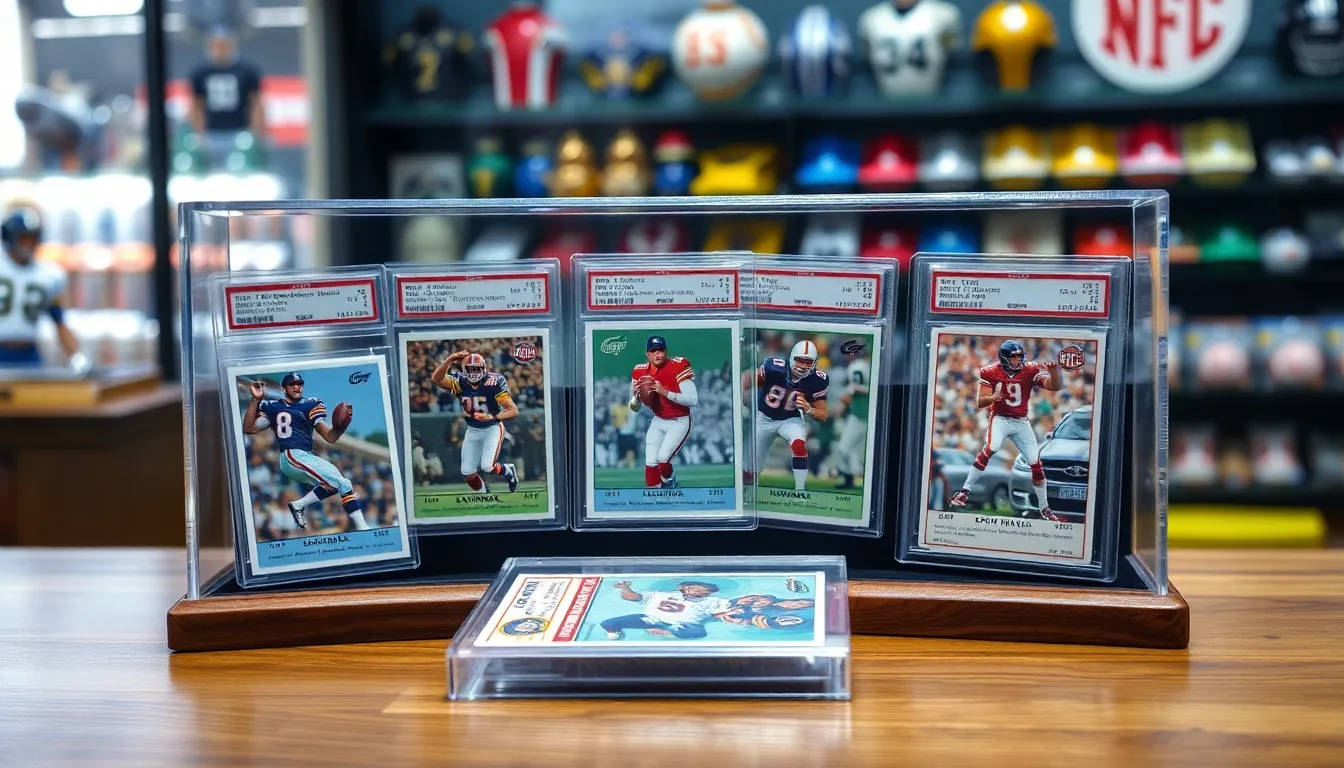In the world of sports memorabilia, few items capture attention like football cards. These collectibles not only celebrate the sport’s rich history but also serve as investments that can skyrocket in value. As collectors scour the market for rare finds, one question consistently arises: what is the most expensive football card ever sold?
Recent sales have shattered records, showcasing the fervor surrounding these iconic pieces of sports history. With each auction, the stakes get higher, and the stories behind these cards become just as intriguing as the players themselves. Exploring the most expensive football card offers a glimpse into a passionate community where nostalgia meets serious investment.
Table of Contents
ToggleOverview of Football Cards
Football cards serve as key elements in the sports memorabilia market, acting both as collectibles and financial investments. Collectors often seek cards that feature iconic players, limited editions, or unique attributes, driving their value upwards.
The evolution of football cards began in the late 19th century, with early examples often featuring notable players from that era. Since then, manufacturers have diversified designs and materials, incorporating foil, autographs, and memorabilia pieces. This ongoing innovation enhances the allure and rarity of particular cards.
Recent sales demonstrate the increasing monetary value attributed to specific football cards. For instance, high-profile auctions frequently yield record-breaking prices, underscoring the competitive nature within the collecting community. Interest persists not only in older cards but also in contemporary releases, as newer players establish their legacies.
In addition to financial investment, football cards cultivate nostalgia for enthusiasts. The stories behind players, memorable games, and historic moments contribute to their desirability. Collectors often bond over shared memories, enhancing the camaraderie within this niche community.
The Definition of Expensive


Expensive football cards signify the intersection of rarity, demand, and historical significance. Their value often reflects the evolving nature of the collectibles market.
Criteria for Valuing Football Cards
Valuing football cards involves several key criteria:
- Condition: Cards in pristine condition command higher prices. Grading systems assess their physical state.
- Rarity: Limited production runs increase value. Scarcity drives demand among collectors.
- Historical Significance: Cards associated with iconic players or memorable moments attract premium prices.
- Market Trends: Current demand influences prices. Fluctuating interest impacts valuation significantly.
- Provenance: Cards with a documented history or celebrity ownership elevate their desirability.
Rarity and Demand
Rarity directly correlates with demand in the football card market.
- Limited Editions: Cards produced in limited quantities enhance exclusivity.
- Short Prints: Cards intentionally made scarce encourage competitive bidding among collectors.
- Vintage Cards: Older cards often possess inherent rarity, boosting their appeal and value.
- High Performers: Cards featuring successful and well-known players attract higher demand due to their broad appeal.
- Collective Interest: Trends can shift within the community, causing certain cards to surge in value based on popularity and cultural relevance.
Notable Football Card Sales
Recent football card sales have reached astonishing levels, showcasing the market’s evolving landscape and collectors’ willingness to invest significantly in prized pieces.
Record-Breaking Sales
Record-breaking sales illustrate the enthusiasm for football cards among collectors. The 2021 sale of a 2000 Tom Brady Playoff Contenders Championship Ticket card for $3.1 million set a new benchmark. This card, graded PSA 10, features Brady’s iconic rookie season, adding historical significance that drove demand. Another notable sale includes a 1976 Walter Payton card, which sold for $1.4 million in 2022, making it one of the highest-selling cards featuring a non-quarterback player. These instances exemplify how rarity and player legacy contribute to escalating prices.
Auction House Influence
Auction houses play a pivotal role in facilitating record sales in the football card market. Houses like Goldin Auctions and PWCC Marketplace have gained prominence by hosting high-profile auctions that attract serious bidders. Goldin Auctions achieved remarkable success with the aforementioned Tom Brady card, amplifying its value through competitive bidding. The curated platforms enable sellers to reach broader audiences, enhancing liquidity within the market. Moreover, auction houses often authenticate cards, assuring buyers of quality and condition, which further elevates the perceived value. The strategic marketing of items during auctions significantly influences final sale prices.
What Is the Most Expensive Football Card?
The most expensive football card ever sold exemplifies the intersection of rarity, demand, and historical significance in sports memorabilia. Recent auctions have set remarkable records, showcasing the evolving landscape of the football card market.
Features of the Card
The specific card recognized as the most expensive is a 2000 Tom Brady Playoff Contenders Championship Ticket card, graded 9.5 by PSA. Key features include its limited production run, high grading score, and Tom Brady’s unparalleled legacy as a quarterback. This card, one of only 100 produced, appeals to collectors due to Brady’s seven Super Bowl titles and status as an all-time great. Its design features a glossy finish, sharp edges, and vibrant colors, enhancing visual appeal and desirability.
Historical Significance
The card’s historical significance stems from both the player’s achievements and its place in the evolution of football cards. As a rookie card from Brady’s debut year, it captures a pivotal moment in sports history. Each auction sale reflects growing interest in football’s role in American culture, with memorabilia serving as a tangible connection to legendary players, games, and significant milestones. The auction houses that facilitate these sales, including Goldin Auctions, contribute to the card’s legacy by ensuring rigorous authentication and quality standards, which reinforce its value in the collector’s market.
Future Trends in Football Card Valuations
Football card valuations are poised for notable changes as collectors adapt to evolving market dynamics. Collectors and investors increasingly factor in emerging trends that shape demand and pricing.
Increased Interest in Vintage Cards
Vintage cards, particularly those from the 1980s and 1990s, continue to gain attention. The nostalgia associated with early collecting experiences drives demand, causing prices to rise. Recent sales demonstrate that collectors are willing to invest in high-grade examples of iconic players.
Digital Collectibles and NFTs
The rise of digital collectibles and non-fungible tokens (NFTs) is transforming the landscape. Many collectors view NFTs as the next frontier for card collecting, blending tradition with technology. Sales of sports-related NFTs have already reached millions, indicating a shift in how collectors perceive value.
Greater Focus on Condition and Grading
Condition significantly impacts valuations. As grading companies enhance their services, collectors will likely prioritize high-graded cards. Graded cards with higher scores command premium prices, reinforcing the connection between quality and value.
Community Influence and Market Dynamics
The influence of online communities and social media continues to grow. As collectors engage in discussions and showcase their collections, market trends often shift rapidly. This engagement fuels interest and can propel certain cards to newfound heights.
Continued Rise of High-Performing Players
Cards featuring high-performing players, especially those with strong legacies or recent achievements, maintain popularity. As athletes break records and gain notoriety, their cards often see significant increases in value. Collectors are expected to gravitate toward cards linked to star players.
Investment as a Primary Motivation
Investment potential increasingly motivates collectors. The trend indicates a shift toward viewing cards as financial assets rather than mere collectibles. This perspective enhances market activity, leading to greater liquidity and substantiated valuations.
Auctions and Marketplaces Adapting
Auction houses and online marketplaces are adapting to these trends by providing better tools and platforms for collectors. Enhanced transparency, authentication processes, and auction formats attract wider audiences. Ongoing innovations will shape the way buyers and sellers interact within the market.
As these trends unfold, they highlight the dynamic nature of football card valuations, reflecting changing collector preferences and financial motivations.


